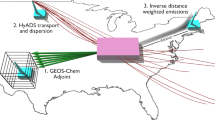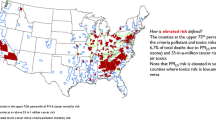Abstract
Source resolution and risk apportionment of emission source categories for risk reduction purposes can be used to enhance the Bubble Policy of the Clean Air Act. This is performed by incorporating receptor modeling techniques of factor analysis and chemical mass balances to assess noncarcinogenic and carcinogenic inhalation risks to a target population for certain pollutants coming from major emission source categories in a steel plant air shed. Source resolution, using factor analysis, statistically interprets a “source” from ambient data. By subsequently quantifying risks from identified metal emission sources using chemical mass balances and risk apportionment, a total additive risk from main source contributors in the steel plant is estimated. From this methodology, the Bubble Policy can be enhanced by targeting only main risk sources or by “risk-trading” with minor impact sources to reduce the total risk (if deemed significant) without arbitrarily reducing risk for all sources in an industrial source complex’s “bubble.”
Similar content being viewed by others
Literature Cited
Anderson, T. W., and H. Rubin. 1956. Statistical inference in factor analysis. Pages 111–150in J. Neyman (ed.), Proceedings of the third Berkeley symposium on mathematical statistics and probability, volume V. University of California Press, Berkeley, California.
Biswas, P., and S. Mukerjee. 1991. Particulate source apportionment in Greater Cincinnati—risk apportionment as applied to an iron-steel foundry air shed (91-82.1). Pages 1–15in 84th annual meeting of the Air and Waste Management Association, 17–21 June 1991. Vancóuver, British Columbia.
Borowsky, A. R., and H. M. Ellis. 1987. Summary of the final federal Emissions Trading Policy.Journal of the Air Pollution Control Association 37:798–800.
Bowers, J. F., A. J. Anderson, and W. R. Hargraves. 1982. Tests of the industrial source complex (ISC) dispersion model at the Armco Middletown, Ohio steel mill. US EPA Publication EPA-450/4-82-006. US EPA, Research Triangle Park, North Carolina, 468 pp.
Brady, G. L. 1983. A step forward? An economic approach in air quality management.Environmental Policy and Law 10:3–11.
Butler, C. 1984. New source netting in non-attainment areas under the Clean Air Act.Ecology Law Quarterly 11:343–372.
Core, J. E., J. J. Shah, and J. A. Cooper. 1984. Receptor model source composition library. US EPA Publication EPA-450/4-85-002. US EPA, Research Triangle Park, North Carolina, 327 pp.
Gordon, G. E. 1980. Receptor models.Environmental Science and Technology 14:792–800.
Gordon, G. E. 1988. Receptor models.Environmental Science and Technology 22:1132–1142.
Hahn, R. W., and G. L. Hester. 1989. Marketable permits: Lessons for theory and practice.Ecology Law Quarterly 16:361–406.
Harman, H. H. 1976. Modern factor analysis, 3rd ed. University of Chicago Press, Chicago, Illinois, 474 pp.
Hopke, P. K. 1985. Receptor modeling in environmental chemistry. John Wiley & Sons, New York, New York, 319 pp.
Johnson, R. A., and D. W. Wichern. 1982. Applied multivariate statistical analysis. Prentice-Hall, Engelwood Cliffs, New Jersey, 594 pp.
Kelly, K. E. 1984. Methodologies for assessing the health risks of hazardous waste incinerator stack emissions to surrounding populations.Hazardous Waste 1:507–531.
Landau, J. L. 1985. Chevron, U.S.A. v. NRDC: The Supreme Court declines to burst EPA’s bubble concept.Environmental Law 15:285–308.
Lioy, P. J., T. J. Kniep, and J. M. Daisey. 1985. Receptor model technical series VI: A guide to the use of factor analysis and multiple regression (FA/MR) techniques in source apportionment. US EPA Publication EPA-450/4-85-007. US EPA, Research Triangle Park, North Carolina, 110 pp.
Liroff, R. A. 1986. Reforming air pollution regulation: The toil and trouble of EPA’s bubble. The Conservation Foundation, Washington, DC, 186 pp.
Lloyd, O. L. 1978. Respiratory-cancer clustering associated with localised industrial air pollution.The Lancet 1:318–320.
Maloney, M. T., and B. Yandle. 1980. Bubbles and efficiency. Cleaner air at lower cost.Regulation 4:49–52.
Mukerjee, D., and D. H. Cleverly. 1987. Strategies for assessing risk from exposure to polychlorinated dibenzo-p-dioxins and dibenzofurans emitted from municipal incinerators.Waste Management and Research 5:269–283.
Mukerjee, S., and P. Biswas. 1992. A concept of risk apportionment of air emission sources for risk reduction considerations.Environmental Technology 13:635–646.
Mukerjee, S., P. A. Succop, and P. Biswas. 1991. Maximum likelihood factor analysis and its comparison to principal component analysis for resolution of emission sources.Atmospheric Environment (submitted).
Nulty, P. 1979. A brave experiment in pollution control.Fortune 99:120–123.
PEDCo Environmental, Inc. 1981. Alternative NAAQS for particulate emissions from steel industry sources: Impacts on an example steel plant. US EPA Contract 68-02-3390. PEDCo Environmental, Inc., Cincinnati, Ohio, 187 pp.
Quarles, J., and W. H. Lewis. 1990. The new Clean Air Act. A guide to the clean air program as amended in 1990. Morgan, Lewis & Bockius, Washington, DC, 102 pp.
Raufer, R. K., S. L. Feldman, and J. A. Jaksch. 1986. Emissions trading and acid deposition control: the need for ERC leasing.Journal of the Air Pollution Control Association 36:574–580.
Roscoe, B. A., P. K. Hopke, S. L. Dattner, and J. M. Jenks. 1982. The use of principal component factor analysis to interpret particulate compositional data sets.Journal of the Air Pollution Control Association 32:637–642.
SAS Institute. 1985. SAS user’s guide: Statistics, version 5 edition. SAS Institute, Cary, North Carolina, 956 pp.
Squillace, M. 1988. Environmental law. Vol 3: Air pollution. Anderson Publishing Company, Cincinnati, Ohio, 545 pp.
Steiner, B. A. 1984. Fugitive dust control in iron and steel plants. Pages 1–5in Thirty-First Ontario Industrial Waste Conference, 17–20 June 1984. Toronto, Ontario.
Streets, D. G., D. B. Garvey, P. J. Grogan, D. A. Hanson, and L. D. Carter. 1984. A regional, new source bubble policy: Its advantages illustrates for the state of Illinois.Journal of the Air Pollution Control Association 34:25–31.
Turner, D. B. 1974. Workbook of atmospheric dispersion estimates. US EPA Publication AP-26. US EPA, Research Triangle Park, North Carolina, 84 pp.
US Environmental Protection Agency. 1981a. Receptor model technical series. Vol II. Chemical mass balance. US EPA Publication EPA-450/4-81-016b. US EPA, Research Triangle Park, North Carolina, 132 pp.
US Environmental Protection Agency. 1981b. Requirements for preparation, adoption and submittal of implementation plans and approval and promulgation of implementation plans.Federal Register 46:50765–50771.
US Environmental Protection Agency. 1985a. Health assessment document for nickel. US EPA Publication EPA/600/3-83/012F. US EPA, Washington, DC, 433 pp.
US Environmental Protection Agency. 1985b. Health assessment document for polychlorinated dibenzo-p-dioxins. US EPA Publication EPA/600/8-84/014F. US EPA, Washington, DC, 612 pp.
US Environmenal Protection Agency. 1986. Part III. Emissions Trading Policy statement, general principals for creation, banking and use of emission reduction credits; final policy statement and accompanying technical issues document.Federal Register 51:43813–43860.
US Environmental Protection Agency. 1987a. Municipal waste combustion study. Assessment of health risks with municipal waste combustion emissions. US EPA Publication Number: EPA/530-SW-87-021g). US EPA, Washington, DC, 232 pp.
US Environmental Protection Agency. 1987b. Protocol for applying and validating the CMB model. US EPA Publication EPA-450/4-87-010. US EPA, Research Triangle Park, North Carolina, 57 pp.
US Environmental Protection Agency. 1987c. Industrial Source Complex (ISC) dispersion model user’s guide, 2nd ed (revised), Vol I. US EPA Publication EPA-450/4-88-002a, US EPA, Research Triangle Park, North Carolina, 274 pp.
US Environmental Protection Agency. 1987d. Integrated Risk Information System. Vol II. Chemical files. US EPA Publication EPA/600/8-86/032b. US EPA, Washington, DC.
US Environmental Protection Agency. 1987e. National Air Toxics Information Clearinghouse: Qualitative and quantitative carcinogenic risk assessment. US EPA Publication EPA 450/5-87-003. US EPA, Research Triangle Park, North Carolina, 211 pp.
US Environmental Protection Agency. 1988. Superfund exposure assessment manual. US-EPA Publication EPA/540/1-88/001. US EPA, Washington, DC, 157 pp.
US Environmental Protection Agency. 1989. Risk assessment guidance for Superfund. Vol. I. Human health evaluation manual (part A). Interim final. US-EPA Publication EPA/540/1-89/002). US EPA, Washington, DC, 281 pp.
US Environmental Protection Agency. 1990. Integrated Risk Information System (IRIS) (for IBM PC/AT microcomputers). NTIS Order Number PB90-591330. US EPA, Cincinnati, Ohio.
Watson, J. G., N. F. Robinson, J. C. Chow, R. C. Henry, B. C. Kim, Q. Nguyen, E. L. Meyer, and T. G. Pace. 1990a. Receptor model technical series, vol III (1989 revision). CMB7 user’s manual. US-EPA Publication EPA-450/4-90-004. US EPA, Research Triangle Park, North Carolina, 125 pp.
Watson, J. G., N. F. Robinson, J. C. Chow, R. C. Henry, B. C. Kim, T. G. Pace, E. L. Meyer, and Q. Nguyen. 1990b. The USEPA/DRI chemical mass balance receptor model/CMB 7.0.Environmental Software 5:38–49.
Author information
Authors and Affiliations
Rights and permissions
About this article
Cite this article
Mukerjee, S., Biswas, P. Source resolution and risk apportionment to augment the Bubble Policy: Application to a steel plant “bubble”. Environmental Management 17, 531–543 (1993). https://doi.org/10.1007/BF02394668
Issue Date:
DOI: https://doi.org/10.1007/BF02394668




